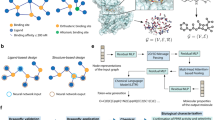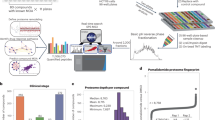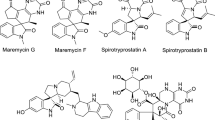Abstract
Aim:
To design and synthesize a novel class of peroxisome proliferator-activated receptors (PPAR)α agonists, which is obtained by the combination of the classical fibrate “head group”, a linker with appropriate length and a chalcone.
Methods:
Thirty seven compounds were designed and identified employing the virtual screening approach. Six compounds were then selected for synthesis and bioassay according to the virtual screening results, structural similarity, and synthetic complexity.
Results:
Six new compounds (4b and 4d-h) were synthesized and bioassayed. All were found to be potent PPARα agonists, compound 4 h being the most prominent with a 50% effective concentration value of 0.06 μmol/L.
Conclusion:
This study provides a promising novel family of chalcones with a potential hypolipidemic effect.
Similar content being viewed by others
Log in or create a free account to read this content
Gain free access to this article, as well as selected content from this journal and more on nature.com
or
References
Anum EA, Adera T . Hypercholesterolemia and coronary heart disease in the elderly: a meta-analysis. Ann Epidemiol 2004; 14: 705–21.
Auboeuf D, Rieusset J, Fajas L, Vallier P, Frering V, Riou JP, et al. Tissue distribution and quantification of the expression of mRNAs of peroxisome proliferator-activated receptors and liver X receptor-alpha in humans: no alteration in adipose tissue of obese and NIDDM patients. Diabetes 1997; 46: 1319–27.
Banner CD, Gottlicher M, Widmark E, Sjovall J, Rafter JJ, Gustafsson JA . A systematic analytical chemistry/cell assay approach to isolate activators of orphan nuclear receptors from biological extracts: characterization of peroxisome proliferator-activated receptor activators in plasma. J Lipid Res 1993; 34: 1583–91.
Chong PH, Bachenheimer BS . Current, new and future treatments in dyslipidaemia and atherosclerosis. Drugs 2000; 60: 55–93.
Brown PJ, Winegar DA, Plunket KD, Moore LB, Lewis MC, Wilson JG, et al. A ureido-thioisobutyric acid (GW9578) is a subtype-selective PPARalpha agonist with potent lipid-lowering activity. J Med Chem 1999; 42: 3785–8.
Bunnelle WH, Dart MJ, Schrimpf MR . Design of ligands for the nicotinic acetylcholine receptors: the quest for selectivity. Curr Top Med Chem 2004; 4: 299–334.
Staels B, Dallongeville J, Auwerx J, Schoonjans K, Leitersdorf E, Fruchart JC . Mechanism of action of fibrates on lipid and lipo-protein metabolism. Circulation 1998; 98: 2088–93.
El-Jack AK, Hamm JK, Pilch PF, Farmer SR . Reconstitution of insulin-sensitive glucose transport in fibroblasts requires expression of both PPARgamma and C/EBPalpha. J Biol Chem 1999; 274: 7946–51.
Willson TM, Brown PJ, Sternbach DD, Henke BR . The PPARs: from orphan receptors to drug discovery. J Med Chem 2000; 43: 527–50.
Hertz R, Bishara-Shieban J, Bar-Tana J . Mode of action of per-oxisome proliferators as hypolipidemic drugs. Suppression of apolipoprotein C-III. J Biol Chem 1995; 270: 13 470–5.
Kliewer SA, Umesono K, Noonan DJ, Heyman RA, Evans RM . Convergence of 9-cis retinoic acid and peroxisome proliferator signalling pathways through heterodimer formation of their receptors. Nature 1992; 358: 771–4.
Lehmann JM, Moore LB, Smith-Oliver TA, Wilkison WO, Willson TM, Kliewer SA . An antidiabetic thiazolidinedione is a high affinity ligand for peroxisome proliferator-activated receptor gamma (PPAR gamma). J Biol Chem 1995; 270: 12 953–6.
Berthou L, Duverger N, Emmanuel F, Langouet S, Auwerx J, Guillouzo A, et al. Opposite regulation of human versus mouse apolipoprotein A-I by fibrates in human apolipoprotein A-I transgenic mice. J Clin Invest 1996; 97: 2408–16.
Li Z, Liao C, Ko BC, Shan S, Tong EH, Yin Z, et al. Design, synthesis, and evaluation of a new class of noncyclic 1,3-dicarbonyl compounds as PPARalpha selective activators. Bioorg Med Chem Lett 2004; 14: 3507–11.
Mangelsdorf DJ, Thummel C, Beato M, Herrlich P, Schutz G, Umesono K, et al. The nuclear receptor superfamily: the second decade. Cell 1995; 83: 835–9.
Nolte RT, Wisely GB, Westin S, Cobb JE, Lambert MH, Kurokawa R, et al. Ligand binding and co-activator assembly of the peroxisome proliferator-activated receptor-gamma. Nature 1998; 395: 137–43.
Delerive P, De Bosscher K, Besnard S, Vanden Berghe W, Peters JM, Gonzalez FJ, et al. Peroxisome proliferator-activated receptor alpha negatively regulates the vascular inflammatory gene response by negative cross-talk with transcription factors NF-kappaB and AP-1. J Biol Chem 1999; 274: 32 048–54.
Forman BM, Chen J, Evans RM . Hypolipidemic drugs, polyun-saturated fatty acids, and eicosanoids are ligands for peroxisome proliferator-activated receptors alpha and delta. Proc Natl Acad Sci USA 1997; 94: 4312–7.
Pinelli A, Godio C, Laghezza A, Mitro N, Fracchiolla G, Tortorella V, et al. Synthesis, biological evaluation, and molecular modeling investigation of new chiral fibrates with PPARalpha and PPARgamma agonist activity. J Med Chem 2005; 48: 5509–19.
Wahli W, Braissant O, Desvergne B . Peroxisome proliferator activated receptors: transcriptional regulators of adipogenesis, lipid metabolism and more. Chem Biol 1995; 2: 261–6.
Wang JL, Liu D, Zhang ZJ, Shan S, Han X, Srinivasula SM, et al. Structure-based discovery of an organic compound that binds Bcl-2 protein and induces apoptosis of tumor cells. Proc Natl Acad Sci USA 2000; 97: 7124–9.
Ni LM, Meng CQ, Sikorski JA . Recent advances in therapeutic chalcones. Exp Opin Ther Patents 2004; 14: 1669–91.
Sierra ML, Beneton V, Boullay AB, Boyer T, Brewster AG, Donche F, et al. Substituted 2-[(4-aminomethyl)phenoxy]-2-methylpro-pionic acid PPARalpha agonists. 1. Discovery of a novel series of potent HDLc raising agents. J Med Chem 2007; 50: 685–95.
Morris GM, Goodsell DS, Halliday RS, Huey R, Hart WE, Belew RK, et al. Automated docking using a Lamarckian genetic algorithm and an empirical binding free energy function. J Comput Chem 1998; 19: 1639–62.
Tanaka N, Tamai T, Mukaiyama H, Hirabayashi A, Muranaka H, Ishikawa T, et al. Beta(3)-adrenoceptor agonists for the treatment of frequent urination and urinary incontinence: 2-[4-(2-[[(1S,2R)-2-hydroxy-2-(4-hydroxyphenyl)-1-methylethyl] amino]ethyl) phenoxy]-2-methylpropionic acid. Bioorg Med Chem 2001; 9: 3265–71.
Ahn C, Correia R, DeShong P . Mechanistic study of the Mitsunobu reaction. J Org Chem 2002; 67: 1751–3.
Daskiewicz JB, Depeint F, Viornery L, Bayet C, Comte-Sarrazin G, Comte G, et al. Effects of flavonoids on cell proliferation and caspase activation in a human colonic cell line HT29: an SAR study. J Med Chem 2005; 48: 2790–804.
Park H, Lee J, Lee S . Critical assessment of the automated AutoDock as a new docking tool for virtual screening. Proteins 2006; 65: 549–54.
Marcus SL, Miyata KS, Rachubinski RA, Capone JP . Transactivation by PPAR/RXR heterodimers in yeast is potentiated by exogenous fatty acid via a pathway requiring intact peroxisomes. Gene Expr 1995; 4: 227–39.
Henke BR, Blanchard SG, Brackeen MF, Brown KK, Cobb JE, Collins JL, et al. N-(2-Benzoylphenyl)-L-tyrosine PPARγ agonists. 1. Discovery of a novel series of potent antihyperglycemic and antihyperlipidemic agents. J Med Chem 1998; 41: 5020–36.
Zheng SX, Luo XM, Chen G, Zhu WL, Shen JH, Chen KX, et al. A new rapid and effective chemistry space filter in recognizing a druglike database. J Chem Inf Model 2005; 45: 856–62.
Chen G . Structure-based combinatorial focus library design: Methodologies and applications. [ PhD Thesis]. Shanghai: Shanghai Institute of Materia Medica; 2003.
Author information
Authors and Affiliations
Corresponding author
Additional information
Project supported by grants from the National Natural Science Foundation of China (No 30623008) and the Dengshan Project from the Shanghai Science and Technology Commission (No 064319015).
Rights and permissions
About this article
Cite this article
Li, Xh., Zou, Hj., Wu, Ah. et al. Structure-based drug design of a novel family of chalcones as PPARα agonists: virtual screening, synthesis, and biological activities in vitro. Acta Pharmacol Sin 28, 2040–2052 (2007). https://doi.org/10.1111/j.1745-7254.2007.00670.x
Received:
Accepted:
Issue date:
DOI: https://doi.org/10.1111/j.1745-7254.2007.00670.x



